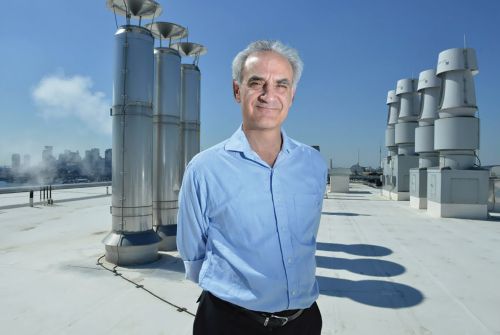IEEE Pulse spoke with Gary Cohen, co-founder and president of Health Care Without Harm, on the urgent need for sustainability in the health care sector
Given the urgency of our climate change problem, a trip to the hospital can be more than just a bit disconcerting for what it reveals about waste. From disposable blood pressure cuffs and one-use plastic medical gowns to powerful air filtration systems that consume immense quantities of energy, waste seems rife. Hospitals might argue that many of these measures are necessary to tamp down hospital-acquired infections, and indeed the U.S. Occupational Safety and Health Administration (OSHA) has required that hospitals dial up their air purification systems to battle COVID-19.
But still, is there a better way?
According to The Commonwealth Fund, the health care system accounts for about 10% of the carbon dioxide emitted annually in the United States. American hospitals produce approximately 6 million tons of waste each year, according to one market research firm, and use approximately 7% of all water used in commercial and institutional settings, according to Practice Greenhealth, a membership organization of health care organizations committed to sustainable practices. Health care facilities consume close to 10% of the total energy used in U.S. commercial buildings and spend more than $8 billion on energy every year. Clearly, as we prepare for more extreme storms, wildfires, and floods, these wasteful practices can’t go on. In recognition of the dire need for action, in August 2021, the Biden Administration announced the formation of the Office of Climate Change and Health Equity, to focus exactly on this problem.
IEEE Pulse talked with Gary Cohen, co-founder and president of Health Care Without Harm, an international nongovernmental organization dedicated to moving the health care sector toward sustainability (Figures 1 and 2). The nonprofit was created in 1996 after the U.S. Environmental Protection Agency identified medical waste incineration as the leading source of carcinogenic dioxins. Since then, the organization of hospitals and health care systems, medical professionals, community groups, environmental health organizations, and labor unions has broadened out to more than 72 countries, working to encourage hospitals and health care providers around the globe to support environmental initiatives. In 2013, President Obama awarded Cohen the Champion of Change Award for Climate Change and Public Health. In 2015, Cohen received a MacArthur Fellowship and “Genius Grant.” Our conversation launches a continuing series of articles focused on sustainability in the health care and medical device sectors.

IEEE Pulse: When it comes to sustainability, what do you believe to be the most critical issue facing hospitals and health care systems today?
Gary Cohen: The climate crisis is essentially a global public health crisis. Health care is in a unique position, which is that it’s a major contributor to greenhouse gas emissions through its operations and supply chains. It can play a critical role in society to address the health impacts related to climate change. Clearly, the climate crisis is a force multiplier for all of the health, economic, and racial inequities that we already face in our society that have also been exposed through the COVID crisis. Health care playing some critical role in addressing the climate crisis is by far the most important strategic imperative that we face.
IEEE Pulse: So, when you’re talking about climate, you’re talking specifically about carbon emissions being one of the most important areas for health care systems and hospitals to address. And my understanding is that health care accounts for about 10% of the carbon dioxide emitted annually in the U.S. each year.
GC: Yes, it’s in the ballpark of 10%. We did an analysis a couple of years ago and looked at global health care emissions and found that the health care sector was responsible for about 4.5% of global emissions. And if you translate, that is the equivalent of the annual emissions of over 500 coal-fired power plants. It’s a lot. If health care were a country—and of course it’s not, it’s spread across a couple of hundred countries—it would be the fifth largest climate polluter on the planet. And inside that 4.5% globally, the U.S. health care sector is responsible for 27% of all those emissions. From a global point of view, it’s massive. And so, the health care sector has a responsibility to address those emissions.
IEEE Pulse: And what’s behind all those carbon emissions?
GC: We would say fossil fuels. The burning of fossil fuels, according to some recent reports from the Harvard School of Public Health, is killing eight million people a year. That’s just the burning of fossil fuels and all the respiratory and premature deaths associated with that. So, it’s one of the biggest killers on the planet. Just that. If you add the climate impact of fossil fuels as the leading driver of climate crisis, the imperative to move away from fossil fuels is paramount. And the good news is that as we do it, we will be saving lives, reducing disease, and saving health care costs.
IEEE Pulse: So how can hospitals and health care providers improve?
GC: Part of it is in the energy that the hospitals and health care systems use, the facilities, and the energy they buy. The majority of it is the supply chain. In fact, 75% of carbon emission used are from the supply chain—the stuff hospitals and providers buy. It’s the medical equipment, the plastics, the anesthetic gases, the food, pharmaceuticals. It’s a whole broad set of things that are driving that footprint up. We’ve been focusing on identifying what are those biggest “climate hotspots” and working with health care systems in our country, and around the world, to address them.
IEEE Pulse: Can you give us a few examples of energy-efficient strategies that hospitals are using to reduce their carbon footprint?
GC: So, in a lot of surgeries, somebody will open up a pack, they won’t even use the equipment, and then all that stuff gets thrown away. And so, there’s an industry that exists and that could expand dramatically, that is basically saying, hold on a second, let’s re-sterilize this equipment and use it again. It’s a no-brainer.
There are certain anesthetic gases that are 2000 times more potent than carbon dioxide. That’s desflurane. There are alternatives that are far less polluting and are just as effective for patient care and cost less money. That’s a no-brainer.
So is moving toward a more plant-based diet in the food hospitals serve. Industrial agriculture is a significant contributor to greenhouse gas emissions. So, you’re saying to the hospital to buy less meat, and when you buy meat, buy meat that’s sustainably produced. That’s good for patients because of the concern in hospital with cancer and heart disease, et cetera, but it would also lower costs because meat is the most expensive thing on the menu and it’s also less sustainable. There’s a number of low-hanging fruit solutions that can multisolve, that could address immediate health issues, that can support the transition to a low-carbon sustainable economy and also help address the climate footprint of health care.

IEEE Pulse: So, I’m wondering if hospitals are really interested in this, or does the argument for sustainability fall on deaf ears?
GC: I would say 10 years ago people weren’t listening. It was still too early, and people saw climate as something that was different in both time and space—it’s not going to happen in my lifetime. It’s my grandkids, and it has something to do with melting ice caps and polar bears. Well, now, climate crisis has come home to everybody, whether you are seeing wildfires in California or extreme heat in the northwest that killed 600 people, or hurricanes in the Midwest, or drought, or freezing in Texas. It just keeps going. People are realizing that the climate crisis has come home to America, and around the world. The sense of proximity has changed dramatically. We’ve also been able to create frameworks and rationale and pathways for health care to address this in ways that are manageable.
We’ve created a national leadership group called the Health Care Climate Council. It includes 19 health care systems that represent about 600 hospitals and thousands of buildings and clinics, and they are all making very major climate commitments and doing all sorts of innovative things around the whole climate footprint as a strategic imperative. And they’re showing the way to the rest of the health care sector about how to get there. Now that there’s an Office of Climate Change and Health Equity at the Department of Health Services, I think we’re going to see a great deal of momentum to get the rest of the sector to come along.
IEEE Pulse: In thinking about our readers, some of the people behind medical device design, I’m wondering if you have noticed any shifts toward thinking more sustainably?
GC: I think that there’s a wakeup call for them as well, because in order for health care systems to decarbonize, to meet their own climate goals of 100% renewable energy and zero emissions, they can’t do it without the supply chain. And so, it’s going to require innovation. In a good way. Innovation around a whole set of things, around toxic plastics, around Energy Star MRIs, around more reusable materials, around high-performance windows and energy systems and microgrids. It’s an incredible industrial innovation opportunity for the supply chain. And those that meet that challenge are going to get more contracts. It’s a new design opportunity for all sorts of companies.
Next in the series: IEEE Pulse will look at how hospitals and health care organizations are successfully implementing sustainable strategies.
Further resources
- Health Care Climate Council, Climate Action: A Playbook for Hospitals, Jul. 2020. [Online]. Available: https://climatecouncil.noharm.org/
- Health Care Without Harm and ARUP, Global Road Map for Health Care Decarbonization, 2021. [Online]. Available: https://healthcareclimateaction.org/roadmap
- Health Care Without Ham, Health Care Climate Action, 2021. [Online]. Available: https://healthcareclimateaction.org/



